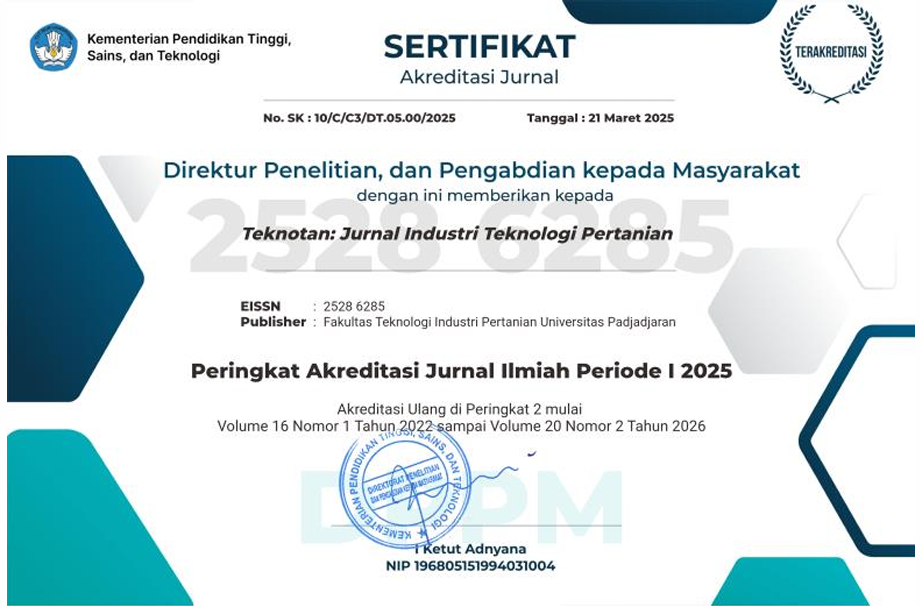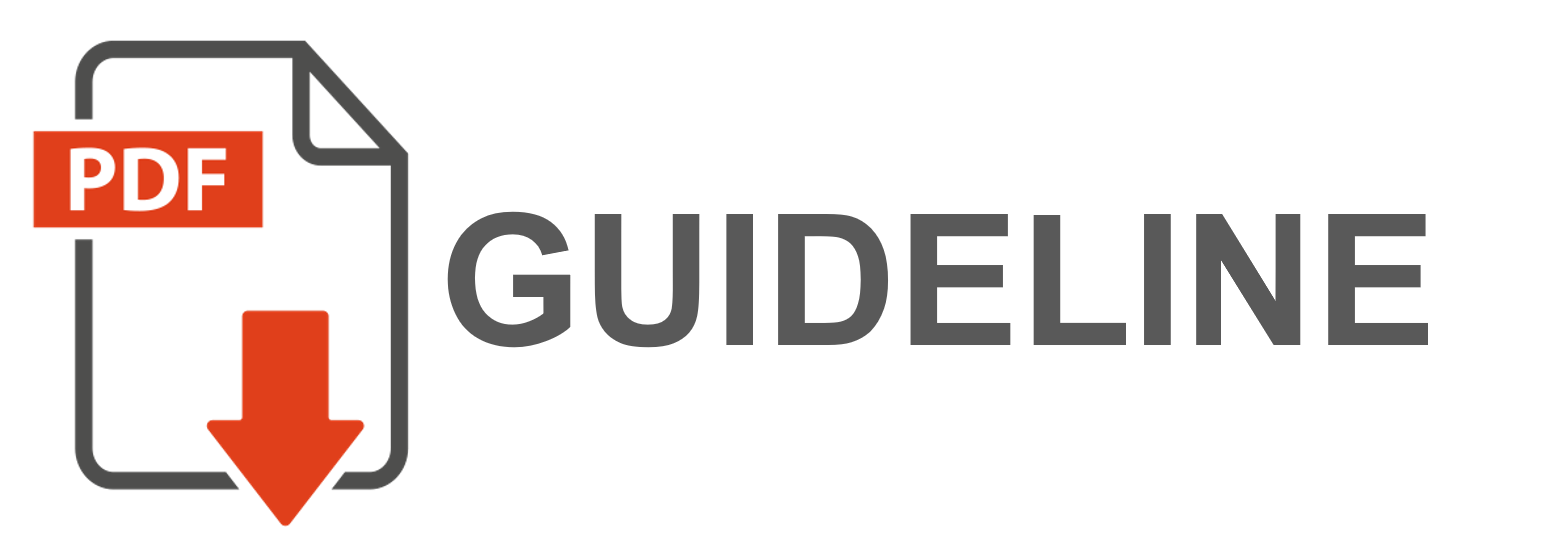Kajian Proses Penyeduhan Teh Herbal Daun Kelor (Moringa oleifera) dan Kayu Manis (Cinnamomum cassia) sebagai Minuman Fungsional
Abstract
Produk teh herbal telah berkembang di kalangan masyarakat karena dapat meningkatkan kesehatan. Daun kelor (Moringa oleifera) dan kayu manis (Cinnamomum cassia) menjadi kandidat bahan teh herbal yang memiliki senyawa metabolit sekunder. Faktor yang mempengaruhi banyaknya metabolit sekunder yaitu rasio, suhu, dan lama penyeduhan. Penelitian ini dilakukan menggunakan metode eksperimental dengan Rancangan Acak Kelompok (RAK) faktorial yang dianalisis dengan analisis sidik ragam (ANOVA) yang dilanjutkan uji Duncan’s Multiple Range Test (DMRT) pada p-value 5% dan uji GLM EM MEANS menggunakan SPSS untuk melihat simple effect dari setiap taraf perlakuan pada interaksi faktor. Penelitian ini bertujuan untuk menganalisis karakteristik nutrisi bahan baku serta mengevaluasi rasio, suhu, dan lama penyeduhan pada seduhan teh herbal daun kelor-kayu manis yang menghasilkan kadar fenolik total tertinggi. Variabel yang digunakan yaitu rasio daun kelor : kayu manis (100:0; 25:75; 50:50; 75;25; dan 0:100), suhu penyeduhan (60oC; 80oC; dan 100oC), dan lama penyeduhan (5 dan 10 menit). Nutrisi yang terkandung dalam daun kelor dan kayu manis dapat berpotensi sebagai bahan yang memiliki nilai fungsional. Hasil skrining fitokimia secara kualitatif daun kelor yang diekstrak dengan aquades terdeteksi adanya alkaloid, saponin, flavonoid, dan tanin, sedangkan pada kayu manis tidak terdeteksi alkaloid. Kadar fenolik seduhan teh berkisar antara 5,42-8,81 mg GAE/g bahan. Perlakuan seduhan teh herbal daun kelor-kayu manis terbaik diperoleh pada rasio 50 : 50 yang diseduh dengan suhu 80°C selama 10 menit menghasilkan kadar fenolik total tertinggi sebesar 8,81±0,03 mg GAE/g bahan.
Keywords
Full Text:
PDF (Bahasa Indonesia)References
Adepoju-Bello, A. A., O. M. Jolayemi, T. S. Ehianeta, and G. A. Ayoola. 2017. “Preliminary Phytochemical Screening, Antioxidant and Antihyperglycaemic Activity of Moringa Oleifera Leaf Extracts.” Pakistan Journal of Pharmaceutical Sciences 30(6):2217–22.
Afifah, R. A., and Chutamat Niwat. 2020. “Phenolic Contents and Antioxidant Activities of Various Infused Tea Liquids Made from Leaves of Green Tea (Camellia Sinensis), Banaba (Lagestroemia Speciosa) and Moringa (Moringa Oleifera L.).” Jurnal Teknologi Pengolahan Pertanian 2(1):15–20.
Alakali, J. S., C. T. Kucha, and A. I. Rabiu. 2015. “Effect of Drying Temperature on the Nutritional Quality of Moringa Oleifera Leaves.” African Journal of Food Science 9(7):395–99.
Ali, M. A., Y. A. Yusof, N. L. Chin, and M. N. Ibrahim. 2017. “Processing of Moringa Leaves as Natural Source of Nutrients by Optimization of Drying and Grinding Mechanism.” Journal of Food Process Engineering 40(6).
AOAC. 2005. Official Methods of Analysis of the Association of Official Analytical Chemists International Arlington. AOAC International.
Asgar, Ali, Darkam Musaddad, ST Rahayu, and Poetry S. Levianny. 2022. “Effect of Temperature and Drying Time on Chemical, Physical and Organoleptic Characteristics of Dry Winged Beans.” IOP Conference Series: Earth and Environmental Science 1024(1):012004.
Ashok, Praveen Kumar, and Kumud Upadhyaya. 2012. “Tannins Are Astringent.” Journal of Pharmacognosy and Phytochemistry 1(3):45–50.
Badan Standarisasi Nasional Indonesia. 2013. “SNI 3836:2013 Teh Kering Dalam Kemasan.” Badan Standarisasi Nasional 1–11.
Berkovich, Liron, Gideon Earon, Ilan Ron, Adam Rimmon, Akiva Vexler, and Shahar Lev-Ari. 2013. “Moringa Oleifera Aqueous Leaf Extract Down-Regulates Nuclear Factor-KappaB and Increases Cytotoxic Effect of Chemotherapy in Pancreatic Cancer Cells.” BMC Complementary and Alternative Medicine 13(212):2–7.
Bernardo, Maria Alexandra, Maria Leonor Silva, Elisabeth Santos, Margarida Maria Moncada, José Brito, Luis Proença, Jaipaul Singh, and Maria Fernanda de Mesquita. 2015. “Effect of Cinnamon Tea on Postprandial Glucose Concentration.” Journal of Diabetes Research 2019:1–6.
Cheraghi, Mostafa, Mehrdad Namdari, Hadis Daraee, and Babak Negahdari. 2017. “Cardioprotective Effect of Magnetic Hydrogel Nanocomposite Loaded N,α-L-Rhamnopyranosyl Vincosamide Isolated from Moringa Oleifera Leaves against Doxorubicin-Induced Cardiac Toxicity in Rats: In Vitro and in Vivo Studies.” Journal of Microencapsulation 34(4):335–41.
Chong, Yoon Kang, and Kar Lin Nyam. 2022. “Effect of Brewing Time and Temperature on the Physical Properties, Antioxidant Activities and Sensory of the Kenaf Leaves Tea.” Journal of Food Science and Technology 59(2):510–17.
Van Chuyen, Hoang, Nguyen Thi Ngoc Hoi, and Jong Bang Eun. 2012. “Improvement of Bixin Extraction Yield and Extraction Quality from Annatto Seed by Modification and Combination of Different Extraction Methods.” International Journal of Food Science and Technology 47(7):1333–38.
Gan, Peck Ting, and Adeline Su Yien Ting. 2019. “Our Tea-Drinking Habits: Effects of Brewing Cycles and Infusion Time on Total Phenol Content and Antioxidants of Common Teas.” Journal of Culinary Science and Technology 17(2):170–83.
Gul, Shumaila, and Mahpara Safdar. 2009. “Proximate Composition and Mineral Analysis of Cinnamon.” Pakistan Journal of Nutrition 8(9):1456–60.
Gulcin, Ilhami, Ruya Kaya, Ahmet C. Goren, Hulya Akincioglu, Meryem Topal, Zeynebe Bingol, Kader Cetin Çakmak, Sevim B. Ozturk Sarikaya, Lokman Durmaz, and Saleh Alwasel. 2019. “Anticholinergic, Antidiabetic and Antioxidant Activities of Cinnamon (Cinnamomum Verum) Bark Extracts: Polyphenol Contents Analysis by LC-MS/MS.” International Journal of Food Properties 22(1):1511–26.
Halim, Y., and Maryani. 2022. “Functional and Sensory Properties of Indonesian Bay Leaf (Syzygium Polyanthum) Herbal Tea.” Food Research 6(2):25–33.
Hamzah, Diza Fathamira. 2019. “Analisis Penggunaan Obat Herbal Pasien Diabetes Mellitus Tipe Ii Di Kota Langsa.” JUMANTIK (Jurnal Ilmiah Penelitian Kesehatan) 4(2):168.
İlyasoğlu, Huri, and Tuba Eda Arpa. 2017. “Effect of Brewing Conditions on Antioxidant Properties of Rosehip Tea Beverage: Study by Response Surface Methodology.” Journal of Food Science and Technology 54(11):3737–43.
Imafidon, Gilbert I., and Frank W. Sosulski. 1990. “Nonprotein Nitrogen Contents of Animal and Plant Foods.” Journal of Agricultural and Food Chemistry 38(1):114–18.
Irwan, Zaki. 2020. “Kandungan Zat Gizi Daun Kelor (Moringa Oleifera) Berdasarkan Metode Pengeringan.” Jurnal Kesehatan Manarang 6(1):69–77.
Kelebek, Hasim. 2016. “LC-DAD-ESI-MS/MS Characterization of Phenolic Constituents in Turkish Black Tea: Effect of Infusion Time and Temperature.” Food Chemistry 204:227–38.
Komes, Draženka, Dunja Horžić, Ana Belščak, Karin Kovačević Ganić, and Ivana Vulić. 2010. “Green Tea Preparation and Its Influence on the Content of Bioactive Compounds.” Food Research International 43(1):167–76.
Kusriningrum R.S. 2008. Perancangan Percobaan. Surabaya: Airlangga University Press.
Leliqia, Ni Putu Eka, I. Ketut Gede Gilang Gama Harta, A. A. Bagus Yoga Saputra, Pande Made Nova Armita Sari, and Ni Putu Linda Laksmiani. 2020. “Aktivitas Antioksidan Kombinasi Fraksi Metanol Virgin Coconut Oil Dan Madu Kele Bali Dengan Metode DPPH (2,2-Diphenyl-1-Picrylhidrazyl).” JPSCR: Journal of Pharmaceutical Science and Clinical Research 5(2):84.
Luthfiyanti, Rohmah, Ade Chandra Iwansyah, Nitra Yustia Pamungkas, and Agus Triyono. 2020. “Penurunan Mutu Senyawa Antioksidan Dan Kadar Air Terhadap Masa Simpan Permen Hisap Ekstrak Daun Ciplukan (Physalis Angulata Linn.).” Jurnal Riset Teknologi Industri 14(1):1.
Ma, Z. F., J. Ahmad, H. Zhang, I. Khan, and S. Muhammad. 2020. “Evaluation of Phytochemical and Medicinal Properties of Moringa (Moringa Oleifera) as a Potential Functional Food.” South African Journal of Botany 129:40–46.
Mahardani, Octavia Trisna, and Leny Yuanita. 2021. “Efek Metode Pengolahan Dan Penyimpanan Terhadap Kadar Senyawa Fenolik Dan Aktivitas Antioksidan.” UNESA Journal of Chemistry 10(1):64–78.
Mokrani, Abderrahmane, and Khodir Madani. 2016. Effect of Solvent, Time and Temperature on the Extraction of Phenolic Compounds and Antioxidant Capacity of Peach (Prunus Persica L.) Fruit. Vol. 162. Elsevier B.V.
Muhammad, Dimas Rahadian Aji, Joel Garcia Juvinal, and Koen Dewettinck. 2020. “The Radical Scavenging Activity and Thermal Stability of Cinnamon Extract-Loaded Nanoparticles.” Caraka Tani: Journal of Sustainable Agriculture 35(1):147.
Narsih, and Agato. 2018. “Efek Kombinasi Suhu Dan Waktu Ekstraksi Terhadap Komponen Senyawa Ekstrak Kulit Lidah Buaya.” Jurnal Galung Tropika 7(1):75.
Ozdal, Tugba, Esra Capanoglu, and Filiz Altay. 2013. “A Review on Protein-Phenolic Interactions and Associated Changes.” Food Research International 51(2):954–70.
Prasad, K. Nagendra, Bao Yang, Xinhong Dong, Guoxiang Jiang, Haiyan Zhang, Haihui Xie, and Yueming Jiang. 2009. “Flavonoid Contents and Antioxidant Activities from Cinnamomum Species.” Innovative Food Science and Emerging Technologies 10(4):627–32.
Putri, Dwi Desmiyeni, and Dwi Eva Nurmagustina. 2017. “Kandungan Total Fenol Dan Aktivitas Antibakteri Kelopak Buah Rosela Merah Dan Ungu Sebagai Kandidat Feed Additive Alami Pada Broiler.” Jurnal Penelitian Pertanian Terapan 14(3):174–80.
Ribeiro-Santos, Regiane, Mariana Andrade, Dayana Madella, Ana Paula Martinazzo, Lívia de Aquino Garcia Moura, Nathália Ramos de Melo, and Ana Sanches-Silva. 2017. “Revisiting an Ancient Spice with Medicinal Purposes: Cinnamon.” Trends in Food Science and Technology 62:154–69.
Rusak, Gordana, Draženka Komes, Saša Likić, Dunja Horžić, and Maja Kovač. 2008. “Phenolic Content and Antioxidative Capacity of Green and White Tea Extracts Depending on Extraction Conditions and the Solvent Used.” Food Chemistry 110(4):852–58.
Sarkar, Marzan, Sujan Bhowmick, Jakir Hussain, Mahmudul Hasan, and Shahdat Hossain. 2017. “Hot Water Extract of Moringa Oleifera Leaves Protects Erythrocytes from Hemolysis and Major Organs from Oxidative Stress in Vitro.” Journal of Basic and Applied Research 3(3):120–26.
Senevirathne, Mahinda, Soo Hyun Kim, Nalin Siriwardhana, Jin Hwan Ha, Ki Wan Lee, and You Jin Jeon. 2006. “Antioxidant Potential Ofecklonia Cavaon Reactive Oxygen Species Scavenging, Metal Chelating, Reducing Power and Lipid Peroxidation Inhibition.” Food Science and Technology International 12(1):27–38.
Sharma, Megha, Alka Gupta, and Ranu Prasad. 2017. “A Review on Herbs, Spices and Functional Food Used in Diseases.” International Journal of Research & Review (Www.Gkpublication.In) 4(January):103.
Siah, WM, MA Azman, K. Jeeven, … MDN Hayazan-J. Trop. Agric. and Fd, and undefined 2011. 2011. “Effect of Infusion Conditions on Total Phenolic Content and Antioxidant Activity in Centella Asiatica Tea.” Citeseer 39(2):149–56.
Siddiqui, Maham. 2021. “Phytochemical Analysis of Some Medicinal Plants.” Liaquat Medical Research Journal 3(8):1–5.
Sonam, Mehta, Rana Pawan Singh, and Pooja Saklani. 2017. “Phytochemical Screening and TLC Profiling of Various Extracts of Reinwardtia Indica.” Recent Advances in Natural Products Analysis 2020:505–6.
Sulaiman, Mohammed, Sulaiman Mohammed, and Fazilah Abd Manan. 2015. “Analysis of Total Phenolics , Tannins and Flavonoids from Moringa Oleifera Seed Extract Analysis of Total Phenolics , Tannins and Flavonoids From.” Journal of Chemical and Pharmaceutical Research 7(1):132–35.
Supriatno, H. Rahmatan, Lelifajri, and S. K. Andesa. 2021. “Effect of Drying and Composition Ratio of Herbal Tea Prepared from Clitoria Ternatea L. And Ocimum Sanctum L. And Its Antioxidant Capacity.” Journal of Physics: Conference Series 1940(1):1–7.
Tacouri, Diksa Devi, Deena Ramful-Baboolall, and Daneshwar Puchooa. 2013. “In Vitro Bioactivity and Phytochemical Screening of Selected Spices Used in Mauritian Foods.” Asian Pacific Journal of Tropical Disease 3(4):253–61.
Vergara-Jimenez, Marcela, Manal Mused Almatrafi, and Maria Luz Fernandez. 2017. “Bioactive Components in Moringa Oleifera Leaves Protect against Chronic Disease.” Antioxidants 6(4):1–13.
Wahyuni, R., W. Wignyanto, S. Wijana, and S. Sucipto. 2020. “Optimization of Protein and Tannin Extraction in Moringa Oleifera Leaf as Antioxidant Source.” Food Research 4(6):2224–32.
Warnis, Minda, Laksmita Adelia Aprilina, and Lilis Maryanti. 2020. “Pengaruh Suhu Pengeringan Simplisia Terhadap Kadar Flavonoid Total Pada Ekstrak Daun Kelor (Moringa Oleifera L.).” Prosiding Seminar Nasional Kahuripan I 265–68.
Wicaksono, Luqman Agung, Sri Djajati, and Arina Nur Evita Laksmi. 2021. “Karakteristik Teh Herbal Daun Kelor (Moringa Oleifera) Dengan Pengkayaan Kolagen Ikan.” Jurnal Ilmu Pangan Dan Hasil Pertanian 4(2):163–80.
Widyawati, Paini Sri, Tarsisius Dwi Wibawa Budianta, Yesiana Dwi Wahyu Werdani, and Maria Olivia Halim. 2018. “Aktivitas Antioksidan Minuman Daun Beluntas Teh Hitam (Pluchea Indica Less-Camelia Sinensis).” Agritech 38(2):200.
Wulandari, R., and PP Utomo. 2019. “Skrinning Fitokimia Dan Aktivitas Antioksidan Teh Herbal.” Jurnal Dinamika Penelitian Industri 30(2):117–22.
Yilmaz, Hilal, Busra Gultekin Subasi, Hasan Ufuk Celebioglu, and Tugba Ozdal. 2022. “Chemistry of Protein-Phenolic Interactions Toward the Microbiota and Microbial Infections.” Front. Nutr 9(July):1–16.
DOI: https://doi.org/10.24198/jt.vol16n3.4
Refbacks
- There are currently no refbacks.
Indexed by:

This work is licensed under a Creative Commons Attribution 4.0 International License (CC BY-SA 4.0)


1.png)
.png)







